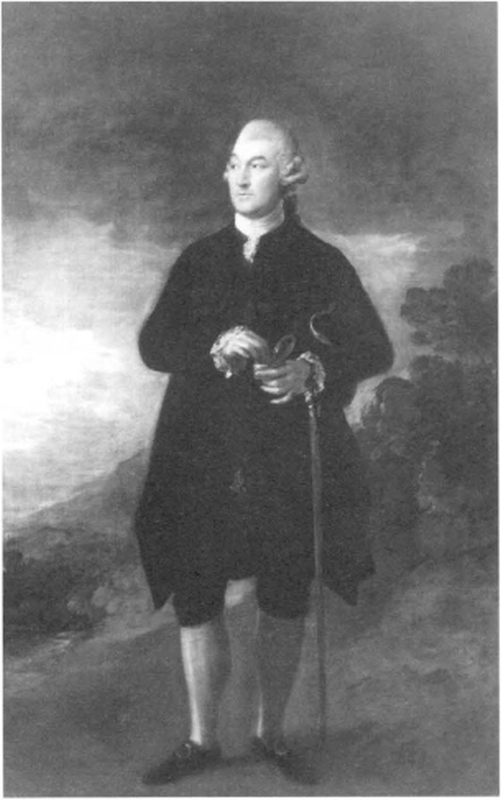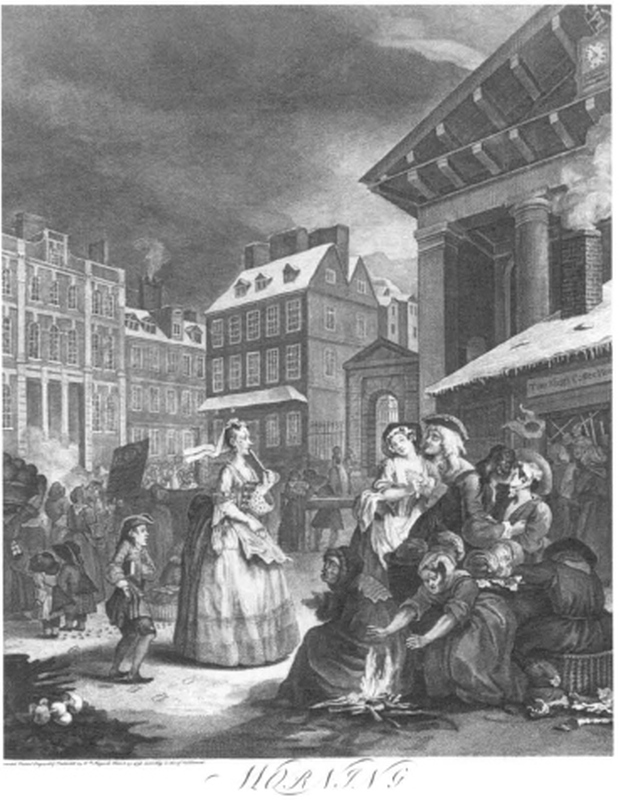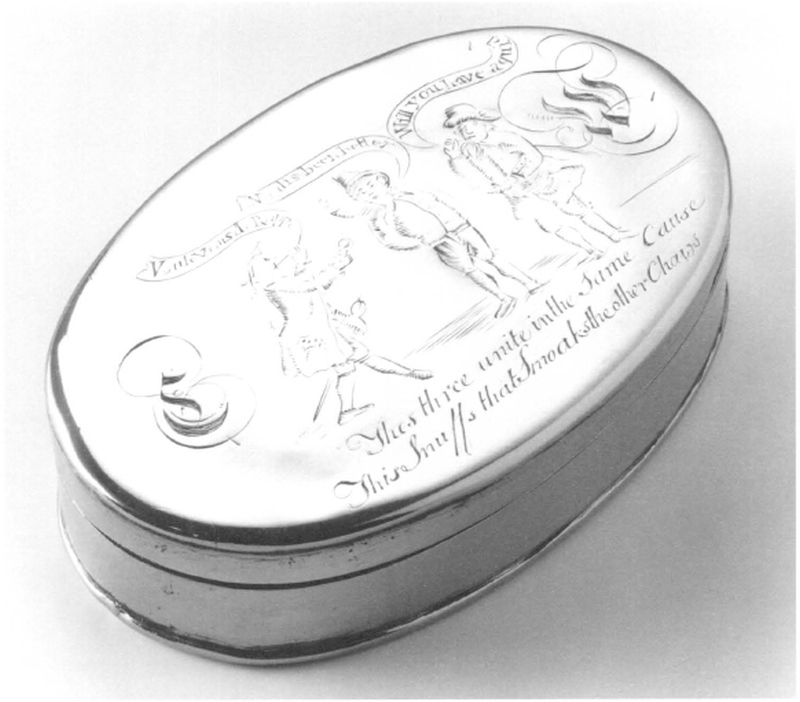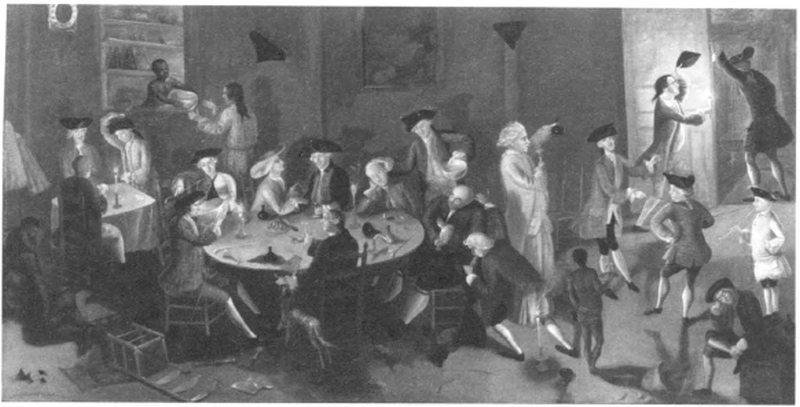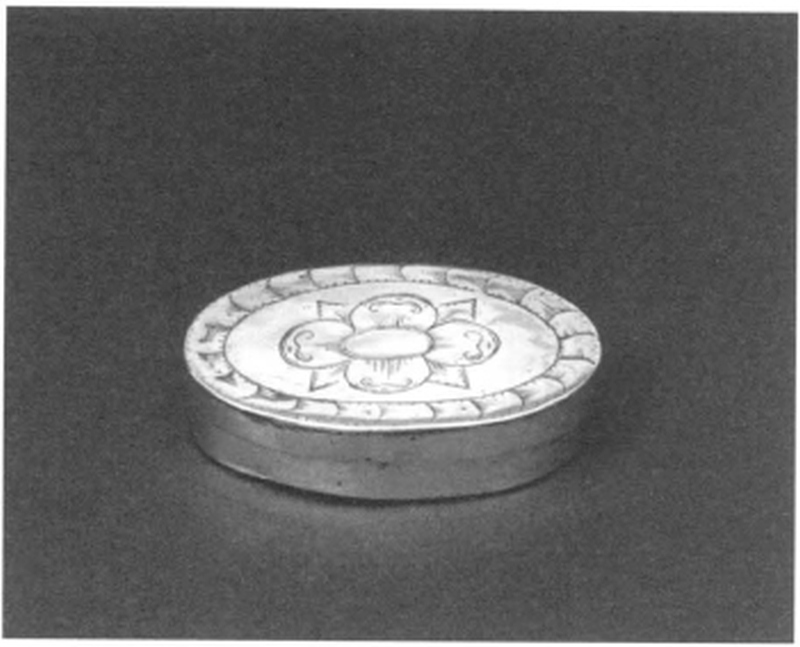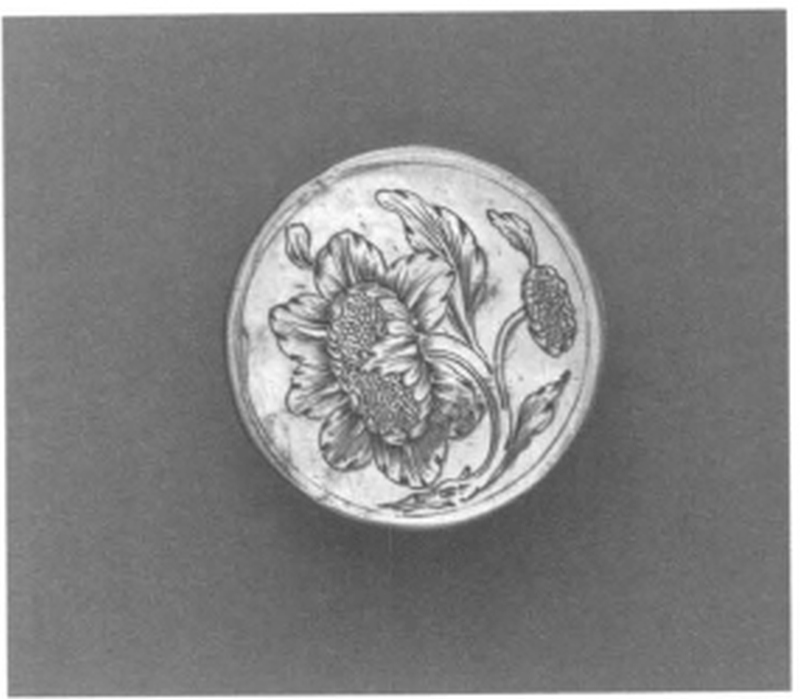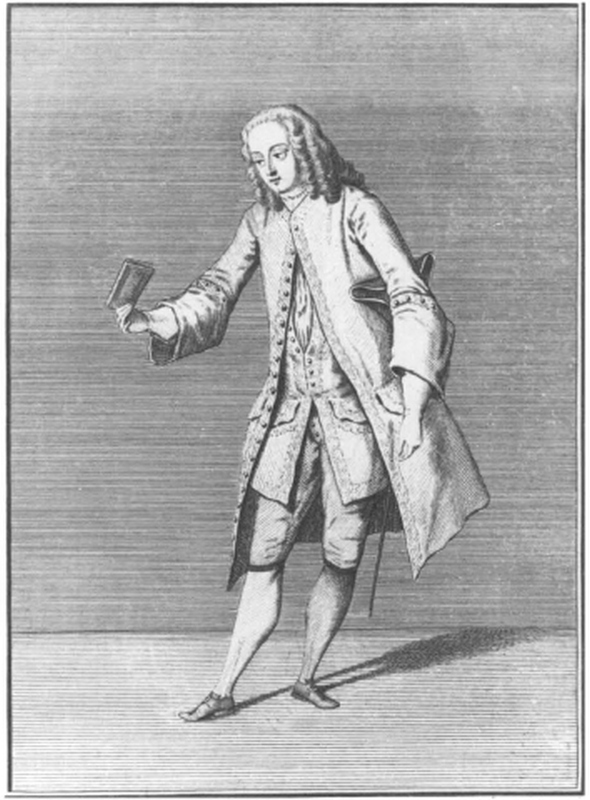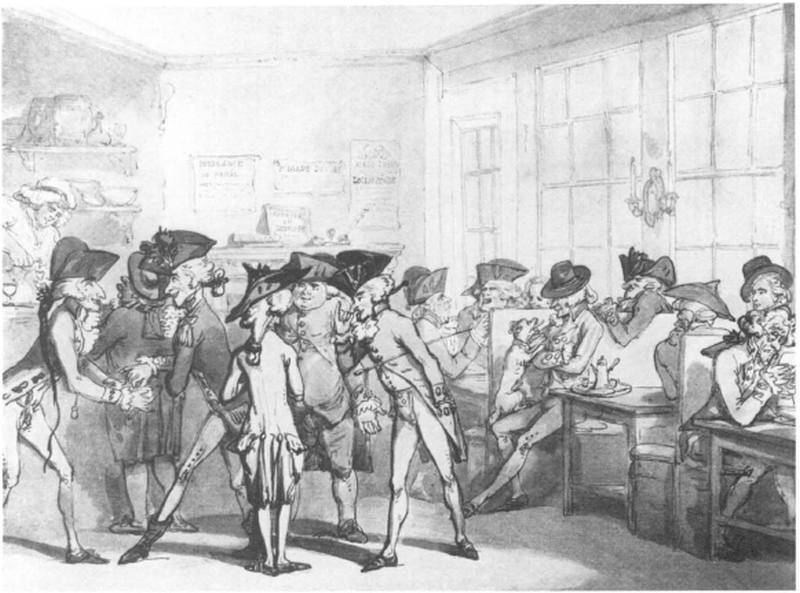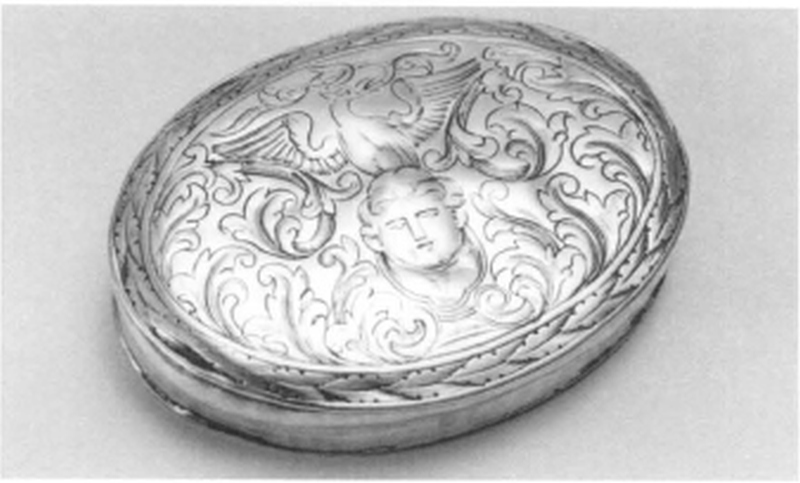Colonial New England Silver Snuff, Tobacco, and Patch Boxes: Indices of Gentility
Madeline Siefke Estill
In a portrait by Thomas Gainsborough from the early 1770s, Englishman Ralph Bell embodies an ideal of stylish grace as he takes a pinch of snuff with a negligent air, holding his silver snuffbox lightly in his elegantly crooked fingers (fig. 1). Together with his fine clothes, walking stick, and attitude of leisured assurance, the box is one of the attributes that establishes him as a gentleman.1 Snuffboxes and their near siblings, tobacco and patch boxes, counted among the “ornaments of life” needed to complete a genteel appearance.2 Their graceful use demonstrated their owners’ knowledge of courtly behavior and promoted a cultural continuity within the Anglo-American world of the seventeenth and eighteenth centuries; a gentleman could be recognized by his behavior and his possessions whether he lived in the Old World or in the New. The boxes both marked social distinctions between classes and affirmed social bonds within a class. This essay illustrates the complex world in which these objects moved by considering them in the rich cultural context of contemporary English and American literary sources such as essays, sermons, poems, and diaries.
Most colonial silver tobacco, snuff, and patch boxes are round or oval in shape, with flat, conforming lids. As a rule, a silversmith fashioned a box from a flat piece of metal onto which he soldered straight, seamed sides; only rarely does a box have sides raised from its base. Lids, whether friction-fit or hinged, generally displayed the same seamed and soldered construction. A craftsman sometimes finished a box with decorative moldings applied to the edge of the base and lid. Although the group of boxes on which this study is based bear the marks of colonial New England silversmiths, the transatlantic scope of this essay reflects an ambiguity in the boxes themselves: although many American craftsmen manufactured boxes, they also imported pieces ready-made from England, to which they could apply their own marks, making it difficult to judge the origin of a given object.3
Similarly, the precise intended use of any box can be hard to ascertain. Colonial craftsmen and owners clearly made distinctions among the various boxes, as evidenced by silversmiths’ advertisements from the period.4 Today, however, it is exceedingly difficult to sort out the features that distinguished one category of box from another. At best, one sometimes may conjecture a box’s planned use, based on its history and decoration, as well as on its general size and type of lid. As a rule, larger boxes with friction-fit lids are catalogued as tobacco boxes, while smaller containers with friction-fit lids are called patch boxes. In turn, boxes made for the purpose of holding snuff would be unlikely to have a removable lid, for it was considered a mark of gentility to be able to gracefully hold a snuffbox in one hand while taking a pinch of snuff with the other.5 A separate lid would defeat the elegant snuffer. By the mid-eighteenth century, however, some silversmiths made patch boxes with hinged lids, as well; neither size nor type of lid alone can point reliably to a box’s intended purpose.6 Furthermore, one must remember that colonial owners used their boxes for purposes other than the one for which they were made: a notice in the Boston Gazette on December 19, 1757, announced: “Taken up in the Street last Thursday, a Silver Snuff Box, with a Mourning Ring in it. The owner may have them again by telling the Marks and paying for this advertisement.”7 Such announcements of lost boxes speak of Americans carrying their boxes with them and using their contents about town.
Fig. 1. Thomas Gainsborough (1727–1788), Ralph Bell (1720–1801), 1772–74. Oil on canvas; h. 92¼ in., w. 61⅛ in. North Carolina Museum of Art, Purchased with funds from the State of North Carolina and the North Carolina Art Society (Robert F. Phifer Funds) (52.9.70).
Despite their usually diminutive size, boxes functioned in seventeenth- and eighteenth-century Anglo-American culture as potent indices of gentility and today can tell us about patterns of colonial social interaction. Like clothing, jewelry, and cosmetics, the silver boxes acted as sign-vehicles in colonial New England, giving clues about their owners’ general socioeconomic status, conception of self, and attitudes toward others.8 Fine objects were the attributes of the genteel, and owning them was the right of the elite. Thus, in The Complete Gentleman (1634), Englishman Henry Peacham argued that “among the prerogatives of the gentleman class is the right to have the best material things.”9 By carrying and using the luxurious silver boxes, colonial men and women set themselves apart from the general population who carried objects associated with their trade or craft. Just as tools were sign-vehicles for craftsmen, so too were the boxes sign-vehicles for men who possessed leisure: one could not work and manipulate a box at the same time.
Patches
Made from a wide range of materials—black silk, velvet, paper, or red leather—and cut into a variety of shapes and sizes, patches were applied to the face or bosom with mastic.10 As understood in their time, they helped to create an impression of formal distinction and enhanced one’s beauty and desirability. Some people who decorated themselves with patches believed the spots made them appear younger and more fashionable, while others used patches to hide blemishes.
In England patches became hugely popular among both men and women in stylish circles by the mid-seventeenth century and continued in vogue through the late 1700s. Advertisements for both patch boxes and patches scattered through colonial newspapers indicate that Americans, well aware of prevailing London fashions, soon followed the British lead. English government officials in colonial America contributed to the spread of such courtly fashions, helping to set the standards of tasteful dress and decorum. Members of the Perm family, for example, were noted for their stylishness; in 1655 Samuel Pepys of London wrote in his famed diary that he had seen Sir William Penn’s daughter Pegg, then only thirteen years old, wearing patches for the first time.11 One may suppose that the Penn family brought their refined taste in dress with them to the colonies. Indeed, American colonists admired leaders who lent a sense of polish and dignity to their offices. In the Massachusetts Bay Colony, the pamphlet Further Quaeries Upon the Present State of New-English Affairs (ca. 1690) advised voters to elect officials “of good Fashion and Quality, and such as maintain the due Grandure of a Government.”12
Fig. 2. William Hogarth (1697–1764), Morning, 1738. Engraving; h. 193⁄16 in., w. 1511⁄16. Museum of Fine Arts, Boston, Harvey D. Parker Collection (P12008).
Nonetheless, the practice of patching still met with mockery and criticism in both England and America. Critics condemned patches for contributing to myriad vices, including lust, vanity, and extravagance. Men who used patches were ridiculed as effeminate fops, young women who wore spots were accused of denigrating God’s handiwork, and older women were mocked for foolishly borrowing the trappings of youth. “Morning,” an engraving published by the English artist William Hogarth in 1738, shows a gaunt old maid making her way through Covent Garden (fig. 2). When seen beside the fresh, young beauty to her right, she seems even older, and the patch high on her cheek becomes sadly out of place. During the Interregnum, Parliament took steps to forbid patching all together. When official disapproval proved ineffectual, it fell to clergymen, moralists, and satirists to contain the fashion.
Ministers charged women who wore patches with deliberately kindling lust in men. In his fiery treatise The Loathsomnesse of Long Haire (1654), Englishman Thomas Hall railed against such wickedness, adding that those who patch bear responsibility not only for their own damnation but for that of the men aroused by their immodest costume as well. He dismissed patches as the badges of harlots and denounced the spots for the irreverence they show for God’s creation.13 In 1647 Nathaniel Ward, the minister of Ipswich, Massachusetts, reprimanded colonial women for following the vagaries of courtly fashion and for dressing above their station. As members of a church-state intended to be a model for all Christian communities, Massachusetts women should not fritter away their colony’s material and spiritual resources by indulging in luxurious fashions.14
Visiting Boston in 1740, preacher George Whitefield measured the residents’ purity of faith by their costume. He sadly noted in his journal that
Boston is a large populous Place, very wealthy. . . . Ministers and People are obliged to confess, that Love of many is waxed cold. Both, for the Generality, seem’d too much conform’d to the World. There’s much of the Pride of Life to be seen in their Assemblies. Jewels, Patches, and Gay Apparel, are commonly worn by the female sex; and even the common People, I observed dress’d up in the Pride of Life.15
Patches figured specifically in Whitefield’s assessment of colonial failings. Like other moralists, he condemned extravagant dress overall, but found it particularly offensive when worn by the lower classes. It was conceited and disrespectful to dress above one’s own station.16
Tobacco
A vignette of three figures, engraved on the lid of an English brass tobacco box dated 1772 (fig. 3), suggests the social stereotypes associated with the three prevalent means of tobacco consumption. A richly dressed gentleman wearing a sword offers a snuffbox to his companions and asks, “Voule Vous de Rapper” (Would you like some snuff?), while the more plainly clad figure in the center holds a pipe and replies in accented tones, “No dis been better.” A coarse, rural character at his side offers his own choice of tobacco and asks, “Will you have a quid?” Beneath runs the motto “This three unite in the Same Cause / This Snuffs that Smoaks the other Chaws.” The box illustrates the broad social appeal of tobacco at the same time that it describes a hierarchy of use.
By the eighteenth century, fashionable Englishmen took their tobacco as snuff. Smoking was associated with soldiers, seamen, country squires, and foreigners; the Dutch were known to be great smokers, which might account for the accent of the brass box’s figure with the pipe. None but rude yokels indulged in the messy habit of chewing tobacco. In America, class distinctions regarding the different uses of tobacco were far less rigid, and colonists were not restricted by their station to choosing one method over another; for example, President John Adams is known to have enjoyed using tobacco in all three forms at various stages in his life.17 Nonetheless, snuffing was largely the urban habit of English and Dutch government officials and merchants, and other colonial leaders, and only slowly spread through society and into the countryside. Throughout the colonial period, smoking remained the most popular means of enjoying tobacco. Tobacco consumption had also played an important role in American life from the very first years of settlement. In his Wonder-Working Providence, Edward Johnson described the homesickness suffered by many of the first settlers to Massachusetts and recounted how they lived through their first bleak winter in the New World, enjoying what familiar comforts that they could: “[making] shift to rub out the Winters cold by the Fireside, having fuell enough growing at their very doores, turning down many a drop of the Bottell, and burning Tobacco with all the Ease they could.”18
Fig. 3. Unknown maker, tobacco box, probably London, England, 1772. Brass; h. 1 in., 1. 4⅛ in., w. 211⁄16 in. Courtesy, Winterthur Museum (1961.1755).
Pleasure and support in times of trial, tobacco also was lauded as a medicinal wonder and source of inspiration. English essayist Sir Richard Steele expressed his fierce devotion to tobacco in a tribute to the tobacco box:
Whoever in a mean Abode presumes
To lodge that sacred Herb, whose curling Fumes
(More grateful than Sabaean Odours far)
Play around the Nose, and wanton in the Air;
May Aesculapius let him always want
The Virtues of the Health-restoring plant . . .
How the defect of Talk it can supply,
If we this way our Breath employ;
How it collects the Thoughts, and serves instead
Of biting Nails, or harrowing up the Head . . .19
For Steele, tobacco was a gift from the gods themselves and deserved to be honored as such; silver containers lent tremendous dignity to the tobacco within. Many shared Steele’s belief in the medicinal powers of tobacco. The plant was extolled as a panacea and credited with curing such diverse ills as indigestion, paralysis, apoplexy, and toothache.20 Nor was Steele alone in his appreciation of tobacco’s stimulating effect on conversation. Avid users of both tobacco and snuff declared that regular consumption cleared their minds and lifted their thoughts. In “Snuff: A Poem,” first published in Edinburgh in 1719, James Arbuckle lauded snuff as a muse and praised snuffboxes as well. He described how holding and using the box skillfully could enhance a man’s talents in conversation: he could command an audience’s attention by pausing, making his listeners wait while he opened his box and took a pinch of snuff. His speech following the pinch then took on greater emphasis. Arbuckle also argued that snuffboxes were necessary tools for ladies intent on showing themselves to best advantage and winning new suitors:
Ten Thousand Killing Airs not yet explor’d,
Does not the Snuff-Box to the Sex afford?
Her Taper Fingers tap the gay Machine.
How many Charms are in that instant seen?21
A lady who could manipulate a snuffbox with elegance drew attention to her beauty and grace.
An aid in courtship and conversation, tobacco became an important feature of social gatherings. In particular, the offer of tobacco functioned as a gesture of friendship. In a 1710 article for the English journal The Tatler, the editor related one visit to his club at which an acquaintance “show[ed] his good-will” by giving him a pipe of tobacco. Feeling indebted by such a friendly gesture, the writer then was obliged to prove his own amiability by listening to his companion’s tedious stories.22
The role of tobacco in colonial taverns mirrored its social functions in genteel London clubs: taverns provided a place to meet with friends and they served liquor—drinking and smoking went hand in hand. Sea Captains Carousing in Surinam, a painting by John Greenwood, illustrates this link (fig. 4) with its view of a group of merchants from Newport, Rhode Island, enjoying a riotous evening in a tavern; the men are drinking punch by the bowl-full, knocking chairs to the floor, and playing tricks on one another. One man staggers about drunkenly, as another vomits, and pipes and tobacco are everywhere.
Fig. 4. John Greenwood (1727–1792), Sea Captains Carousing in Surinam, 1758. Oil on bed ticking; h. 37¼ in; w. 75¼ in. Purchase, St. Louis Art Museum (256.1948).
The part smoking played in the debauched revelry of the eighteenth century was not lost on the critics of tobacco. Even John Adams, himself a smoker, was alarmed at the idle dissipation of the young men of Worcester, Massachusetts, who did not study but embraced sensual pleasures, spending every evening “playing Cards, drinking Punch and Wine, Smoaking Tobacco, swearing &c. while one hundred of the best Books lie on the shelves, Desks, and Chairs, in the same room.”23 If one was smoking, one was not working; colonial moralists sought to prevent their neighbors from falling into lives of idleness and excess.
Critics also recognized the possibility of addiction to tobacco. In a pamphlet addressed to prospective ministers, Cotton Mather expressed his wish that there were more controls on the purchase of tobacco and warned of the hold tobacco could gain on intemperate smokers, reducing them to “Slave[s] to the Pipe.”24 He only reluctantly accepted the careful, medicinal use of smoking tobacco, and he vehemently opposed any use of snuff at all, which he believed to lead to ill-health and dissolute craving for sensual pleasure. He thundered
How shameful a thing it is, for People of Reason to confess that they can’t live easily half an Hour together, without a Delight so sensual, so Trivial, so very Contemptible, as that of Tickling their Olfactory Nerves a little? And even bury themselves alive, in pungent Grains of titillating Dust. . . . A very just Motto for the Snuff-box might be, A LEADER TO THE COFFIN. If it be offer’d you, Away with it! I say again, Away with it!25
For Mather, snuff serviced man’s basest desires and endangered his soul. Unlike smoking tobacco, it had no redeeming qualities whatsoever.
It should be noted, however, that Mather’s criticism of tobacco was not echoed by all church leaders. Indeed, a number of preachers enjoyed tobacco; the Yale collections include silver tobacco and snuffboxes owned by such prominent clergymen as Isaac Stiles, Joseph Burbeen, and William Welsteed. These New England clergymen and their families enjoyed considerable status in their communities and displayed that status through their fine dress, silver, and household furnishings. Another box, also in the Yale collections, belonged to Sarah Pierpont Edwards, wife of Jonathan Edwards and daughter of a celebrated New Haven minister (fig. 5). The box was found at the site of the Stockbridge farm occupied by the Edwardses following their dismissal by the Northampton church. In the wilds of western Massachusetts, surrounded only by the few settlers and Indians to whom her husband ministered, Sarah Edwards continued to use and display silver that made manifest her family’s stature in its community and that set her family apart from its neighbors.
The decoration, as well as the material, of silver snuff, tobacco, and patch boxes bespoke their owners’ genteel aspirations. The possession of a silver box and the knowledge to interpret correctly its decoration were gauges for measuring social standing. Despite living in a society that was not armigerous, socially ambitious New Englanders sometimes borrowed English coats of arms to aggrandize their silver. On the box engraved by John Coney for the Jeffries family (fig. 6), the decoration draws attention to the prestige and power of its owner, his social self-assurance, and his desire to link himself with noble fashion.
Other boxes reflect their owners’ genteel erudition, since the engravings often invoked a knowledge of ancient literature that was the hallmark of the liberal education then reserved for the elite. Box lids frequently bore stylized flowers and foliage, many representing plants that carried symbolic meanings. For example, the sunflower engraved on a box marked by the Boston silver-smith William Rouse refers, via classical mythology, to abiding love (fig. 7). In Metamorphosis Ovid tells the story of the lovers Apollo and Clytie, in which the ignored, jealous Clytie sits so long on the ground, watching the sun god pass above her, that she takes root and turns into a flower; nonetheless, she continues turning her head toward the sun she loves.26 Most likely the sunflower decoration marked the Rouse box as a love token, but it would have failed in that purpose if its recipient were unable to interpret the engraving. Therefore, the box may well speak both of the affection of the colonial couple who exchanged it and of their refined taste and education.
Fig. 5. John Dixwell (1680/81–1725), patch box, Boston, Massachusetts, ca. 1720–25. Silver; w. 1⅞ in. Yale University Art Gallery, Gift of M. C. Edwards (1980.22).
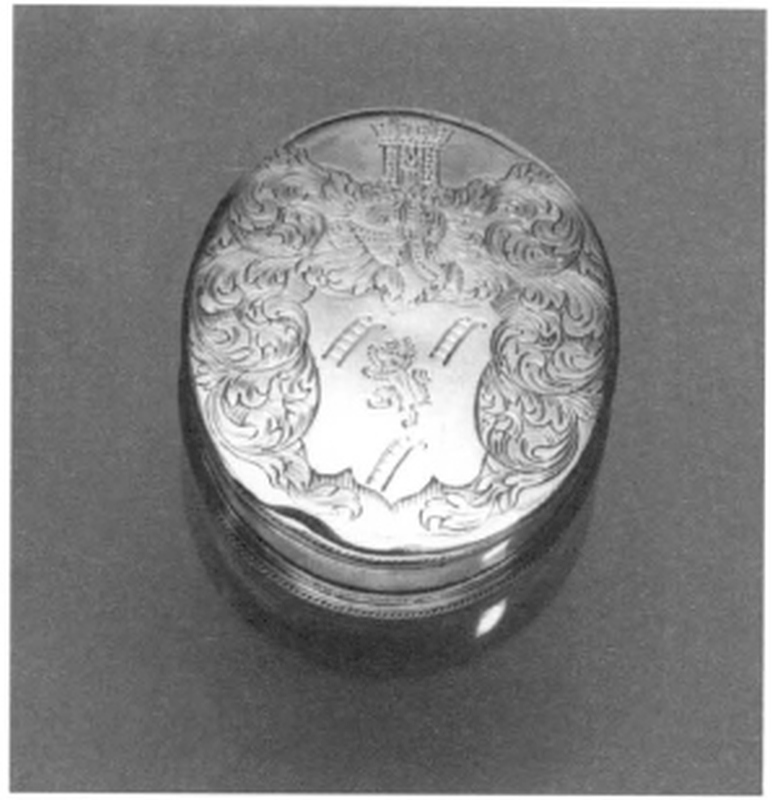
Fig. 6. Unidentified London silversmith, tobacco box, ca. 1681. Engraved by John Coney (1655/56–1722), Boston, Massachusetts, ca. 1701. Silver; 1. 313⁄16 in. Yale University Art Gallery, Mabel Brady Garvan Collection (1935.235).
The possession of a silver box, the knowledge to correctly interpret its decoration, and the ability to skillfully manipulate it in public all commanded considerable cachet. In this, the box became a sign-vehicle in a much larger discourse of the importance of bearing and manners. Gentlemen and social aspirants alike placed great value in knowing the proper, fashionable way to go about small, daily ceremonies, such as using a snuffbox. Dancing classes that taught modish posture and walking, as well as dancing itself, flourished on both sides of the Atlantic, and Americans intent on gentility had a wealth of instructive books to consult in order to polish their bearing. F. Nivelon’s The Rudiments of Genteel Behavior, published in Britain in 1734, gives step-by-step instructions for walking, standing, dancing, and going through other daily motions in a refined fashion, “thereby distinguish[ing] the polite Gentleman from the rude Rustick.”27 One of the engravings in Nivelon’s manual illustrates the proper stance a gentleman should take when giving or receiving an object (fig. 8). The accompanying text describes in daunting detail just how each part of the body should move:
The head and the body to the waist must incline forwards in a circular, easy motion, and the body must rest on the left leg, that knee bending, the right knee straight, and the ball of the foot lightly touching the ground; the right arm must bend at the wrist and elbow to appear a little circular. . . . But at the time of offering or receiving, the arm must be extended, and the look directed to the hand offer’d to, or receiving from, then draw the hand back, and a little circular, as above described, and from that attitude let it fall gently into its proper place.28
Status could be defined by the elegance with which one moved as well as the objects that one owned.
Fig. 7. William Rouse (1639–1705), patch box, Boston, Massachusetts, ca. 1680–90. Silver; h. 11⁄16 in., diam. 115⁄16 in. Yale University Art Gallery, John Marshall Phillips Collection, Gift of his nephews Donald and Marshall Phillips (1955.10.2).
Relying on such complex advice, a gentleman sought to exhibit his gracefulness when offering or receiving snuff, and he would look for similar refinement in those with whom he shared the tobacco. A genteel snuffer strove to handle his box with easy grace, usually holding it in his left hand, while taking a dainty pinch of snuff with the forefinger and thumb of the right hand, as illustrated by the portrait of Ralph Bell (see fig. 1). So powerful a tool was the snuffbox in displaying and defining gentility that in the English comedy The Gentleman Dancing-Master (1672), by William Wycherley, a character is dismissed with the observation “for being well-bred you shall judge . . . to say no more, he ne’er carries a snuff box about with him.”29 In 1711, the satiric London journal The Spectator announced that
The Exercise of the Snuff-Box, according to the most fashionable Airs and Motions . . . will be Taught with the best plain or perfum’d Snuff, at Charles Lillie’s, Perfumer . . . There will be likewise Taught The Ceremony of the Snuff-Box, or Rides for offering Snuff to a Stranger, a Friend, or a Mistress, according to the Degrees of Familiarity or Distance; with an Explanation of the Careless, the Scornful, the Politick, and the Surly Pinch, and the Gestures proper to each of them.30
Albeit tongue-in-cheek, this advertisement reinforced the idea that there were stylish ways to use snuffboxes. Gentility could be acquired through the study of elegant movement and the rules of social hierarchy. Gentlemen strove for the ideal of graceful, unaffected ease.
Fig. 8. From F. Nivelon, The Rudiments of Genteel Behavior (1734), plate 5. The Beinecke Rare Book and Manuscript Library, Yale University.
In all classes, the sharing of tobacco created a sense of communion and reaffirmed feelings of affiliation, much as sharing food and drink would. A print after Thomas Rowlandson’s watercolor “The French Coffee-House” shows one gentleman offering his snuffbox to another (fig. 9). The posture of the recipient echoes that of the donor, strengthening the link between the two as they engage in a common activity. Through the exchange of boxes and their contents Anglo-Americans helped to define their social circles.
Boxes themselves frequently acted as gifts. For example, in his will of 1777, Boston silversmith Nathaniel Hurd bequeathed his tobacco box bearing his name to his brother-in-law John Furness.31 Even after death, Hurd and Furness would be linked by the box, and their familial bonds would be acknowledged. Similarly, the diarist John Smith wrote in 1747 of presenting a Philadelphia lady with a tobacco box in the explicit hope of being remembered whenever she smoked a pipe.32 Thus, a box could transcend its use for storage and act as an “icon of continuity,” inducing memories of events or feelings.33
Fig. 9. Photomechanical reproduction, after Thomas Rowlandson’s drawing, “The French Coffee-House.” From George Paston, Social Caricature in the Eighteenth Century (London: Methuen, 1905), frontispiece. Yale Center for British Art, Paul Mellon Collection.
Some boxes, like the one engraved with the sunflower by William Rouse, reflect in their design or decoration that they were intended as love tokens. For example, a box attributed to Benjamin Brenton of Newport shows a phoenix, symbol of the undying, perching over a putto’s head (fig. 10). The two images together speak of eternal love. A heart-shaped box by the Portsmouth silversmith William Whittemore carries the inscription “A K, This is Thine and Thou art Mine 1734” (fig. 11); its motto is reinforced by its form.
Contemporary literature further substantiates the role silver boxes played in the courtship rituals of the seventeenth and eighteenth centuries. In the poem “Mundus Muliebris,” subtitled “A Voyage to Marryland,” the Englishwoman Mary Evelyn listed patch boxes in her catalogue of the gifts a young man must give to his love; she suggested that a relationship cannot succeed without such presents.34 Furthermore, a suitor might receive a box as proof of a lady’s affection. Popular beaus could accumulate considerable collections of such trophies. Alexander Hamilton noted that Dr. Keith of Newport, a great favorite with the ladies, kept a “cabinet of curiosities” in which he displayed all the objects given him by admiring women, including fans, torn gloves, and snuffboxes.35
Fig. 10. Attributed to Benjamin Brenton (1710–1766), snuffbox, Newport, Rhode Island, 1730–40. Silver; 1. 2⅝ in. Courtesy, Winterthur Museum, Gift of H. F. du Pont (1952.290).
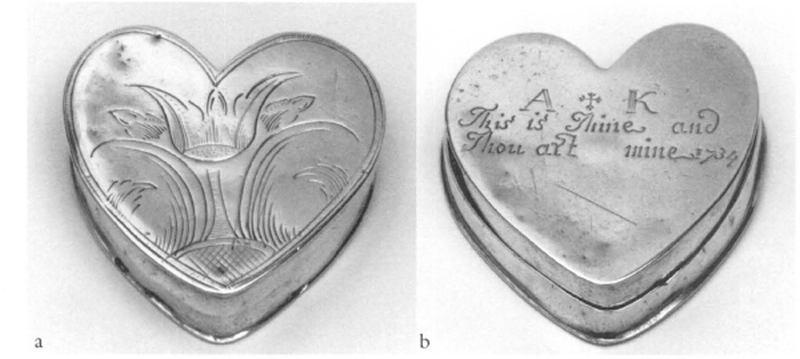
Fig. 11 a (top) and b (bottom). William Whittemore (1709/10–ca. 1770), box, Portsmouth, New Hampshire, ca. 1734 Silver; w. 1⅝ in. Museum of Art, Rhode Island School of Design (63.015).
Thus, colonial silver tobacco, snuff, and patch boxes transcended their manifest function as containers to embrace latent functions as indices of gentility and tools for social interaction. They were used both to create social distance and to create and affirm social bonds. Their graceful use demonstrated their owners’ knowledge of courtly behavior. Their very material transformed the boxes, lending them increased importance; they represented tangible wealth. Furthermore, the polished, reflective silver was inherently beautiful and pleasurable to hold. That pleasure was echoed by the sensual nature of the tobacco and luxurious finery that the boxes held. As manifestations of gentility, and as gifts exchanged within select circles, colonial silver tobacco, snuff, and patch boxes are powerful documents of seventeenth and eighteenth century social hierarchy and patterns of interaction. The boxes’ layers of meaning were potent during the colonial era, and these continue to be powerful for modern students of early American material culture and social history.
Notes
1 A longer version of this essay may be found in Madeline M. Siefke, “Indices of Gentility and Gifts of Convention: Colonial Silver Tobacco, Snuff, and Patch Boxes” (M.A. thesis, University of Delaware, 1991).
2 The Tatler, no. 105 (December 6, 1709), reprinted in Select British Classics (Philadelphia: Samuel F. Bradford, 1803), 24: 308.
3 Few English boxes were hallmarked; completely unmarked boxes as well as ones just bearing makers’ marks were produced both in Britain and America. Either native-made or imported boxes could be decorated by American craftsmen to the specifications of their local customers. The challenge of unraveling just who made, decorated, and sold a particular box is illustrated by a container engraved with the arms of the Jeffries family (fig. 6). The box bears two sets of marks, one belonging to the Boston silversmith John Coney, who probably engraved it, the other set belonging to an unidentified London smith, who made the box ca. 1681. Coney was prepared to make similar boxes himself; his estate inventory lists a tobacco box anvil. See Barbara McLean Ward and Gerald W. R. Ward, eds., Silver in American Life: Selections from the Mabel Brady Garvan and Other Collections at Tale University (New York: American Federation of Arts, 1979), 71.
4 For example, in a series of advertisements in The South Carolina Gazette in the 1730s and 1740s, Charleston goldsmith Lewis Janvier announced that he made and repaired snuffboxes, tobacco boxes, and patch boxes. See Alfred Coxe Prime, comp., The Arts and Crafts in Philadelphia, Maryland, and South Carolina 1721–1785 (New York: The Walpole Society, 1929), 75–76.
5 Making snuff was a long and complex process of cutting, fermenting, drying, grinding, and blending tobacco. Most snuff used in America was imported. Colonial manufacturers advertised the similarity of their product to British snuff and appealed to their customers’ loyalty to local craftsmen. See the Boston Gazette of August 16, 1756, quoted in George Francis Dow, comp., The Arts and Crafts in New England: Gleanings from Boston Newspapers, 1704–1775 (Topsfield, Mass.: Wayside Press, 1927), 280–81.
6 A mid-eighteenth-century engraving by Charles-Antoine Coypel, “Folly Adorns Withered Old Age with the Charms of Youth,” shows an elderly lady clutching a palm-sized, hinged box filled with patches. See Richard Corson, Fashions in Make-up: From Ancient to Modern Times (New York: Universe Books, 1972), 193.
7 Boston Gazette, December 19, 1757, quoted in Dow, Arts and Crafts in New England, 61.
8 In The Presentation of Self in Everyday Life (Garden City, N.Y: Doubleday Anchor Books, 1959), Erving Goffman defines sign-vehicles as objects that carry information about an individual.
9 Henry Peacham, The Complete Gentleman (1634), quoted in Edward J. Nygren, “Edward Winslow’s Sugar Boxes: Colonial Echoes of Courtly Love,” Tale University Art Gallery Bulletin 33, no. 2 (Autumn 1971): 46–48. The Complete Gentleman was known to the colonial American elite, having been listed in A Catalogue of Curious and Valuable Books, which was published in Boston in 1719.
10 Neville Williams, Powder and Paint: A History of the Englishwoman’s Toilet, Elizabeth I—Elizabeth II (London: Longmans, Green and Company, 1957), 19.
11 Samuel Pepys, January 13, 1665, The Diary of Samuel Pepys, 11 vols., ed. Robert Latham and William Matthews (Berkeley: University of California Press, 1983), 6:9.
12 Further Quaeries Upon the Present State of New-English Affairs, quoted in T. H. Breen, The Character of the Good Rader: A Study of Puritan Political Ideas in New England, 1630–1730 (New Haven: Yale University Press, 1970), 176.
13 Thomas Hall, The Loathsomnesse of Long Haire . . . With an Appendix against Painting, Spots, Naked Breasts, &c. (London: J. G. for Nathanael Webb and William Grantham, 1654), 99–103.
14 Nathaniel Ward, The Simple Cobler of Aggawam in America (Boston: Printed for Daniel Henchman, 1713), 30.
15 George Whitefield, A Continuation of the Rev. Mr. Whitefield’s Journal, from A Few Days after his Arrival at Savannah, June the Fourth to his leaving Stamford, the last Town in New-England, October 29, 1740 (Philadelphia: B. Franklin, 1741), 98.
16 For related criticism, see John Barnard, A Present for an Apprentice: or, a Sure Guide to Gain both Esteem and Estate, 4th ed. (Philadelphia: B. Franklin and D. Hall, 1749), 15.
17 John Adams, Diary and Autobiography of John Adams, ed. L. H. Butterfield (Cambridge, Mass.: The Belknap Press, 1961), 1:12–13.
18 Edward Johnson, Johnson’s Wonder-Working Providence, 1628–51, ed. J. Franklin Jameson (New York: Barnes and Noble, 1910), 45.
19 Sir Richard Steele, “On a Tobacco Box,” in Poetical Miscellanies, Consisting of Original Poems and Translations (London: Mr. Steele, 1714), 208–10.
20 Thomas Short, Discourses on Tea, Sugar, Milk, Made-Wines, Spirits, Punch, Tobacco, etc., with Plain and Useful Rules for Gouty People, in Tobacco, its History Illustrated by the Books, Manuscripts, and Engravings in the Library of George Arents, Jr., ed. Jerome E. Brooks (New York: Rosenbach Company, 1937–52), 3: 333. Brooks’s compendium of the Arents collection is an invaluable and exhaustive source for primary materials relating to the history of the European discovery of tobacco in the New World and its subsequent reception and use in Britain.
21 James Arbuckle, “Snuff: A Poem” (London: Printed for F. Cogan, 1732), 3–18.
22 The Tatler, no. 132 (February 11, 1710), in Select British Classics, 25:93.
23 Adams, Diary, 1:76–77.
24 Cotton Mather, Manuductio ad Ministerium. Directions for a Candidate of the Ministry (Boston: Printed for Thomas Hancock, 1726), 133.
25 Mather, Manuductio, 135.
26 Ovid, Metamorphosis, trans. Mary M. Innes (London: Penguin Group, 1955), 99–101.
27 F. Nivelon, The Rudiments of Genteel Behavior (1737), unpaginated.
28 Nivelon, Rudiments, unpaginated.
29 William Wycherley, The Gentleman Dancing-Master, in The Plays of William Wycherley, ed. Peter Holland (Cambridge: Cambridge University Press, 1981), 125.
30 The Spectator, vol. 138 (August 8, 1711), unpaginated. The Spectator was read avidly in the colonies; Benjamin Franklin, Jonathan Edwards, and Cotton Mather are all known to have owned copies, and as early as 1721, Harvard students were publishing their own periodical, The Telltale, based on the English model.
31 Hollis French, Jacob Hurd and His Sons Nathaniel and Benjamin Silversmiths, 1702–1781 (Cambridge, Mass.: Riverside Press for the Walpole Society, 1939), 60.
32 Diary of John Smith, quoted in Kathryn C. Buhler and Graham Hood, American Silver, Garvan and Other Collections in the Tale University Art Gallery, 2 vols. (New Haven: Yale University Press for the Yale University Art Gallery, 1970), 1:141–42.
33 For a discussion of the associative power of objects, see Mihaly Csikszentmihalyi and Eugene Rochberg-Halton, The Meaning of Things: Domestic Symbols and the Self (Cambridge: Cambridge University Press, 1981).
34 Mary Evelyn, “Mundus Muliebris: or, The Ladies Dressing Room Unlock’d, and her Toilette Spread,” in The Miscellaneous Writings of John Evelyn, ed. William Upcott (London: Henry Colburn, 1825), 707–11.
35 Alexander Hamilton, Hamilton’s Itinerarium, ed. Albert Bushnell Hart (St. Louis: William K. Bixby, 1907), 123–24.

